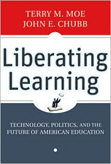Education Next has spilt a lot of ink over three recent books on virtual education. It featured an essay by Clay Christensen and Michael Horn (C&H) that anticipated a full-length account of the best way to disrupt a classroom, opened its forum to Terry Moe and John Chubb (M&C), who made a case later fleshed out in Liberating Learning, and ran an excerpt from my Saving Schools: From Horace Mann to Virtual Learning.
From my not altogether disinterested angle, the books are complements, not competitors. Writing from a business-school perspective, C&H provide compelling analogies from the world of commerce and industry, the most vivid being SONY’s development of the tinny pocket transistor radio, sold to an under-served teen-age market. Pocketing the revenue, SONY acquired the capital needed to upgrade its transistors to the point where it completely destroyed the market for cumbersome, vacuum-tube, console radio and TV sets. Virtual education will do the same to brick-and-mortar schools, they say. Disrupting Class is certainly worthy reading, especially given its breathtaking prediction that half of all high school courses will be offered online within a decade. But C&H’s analysis runs thin when it is tries to explain how disruption will happen in an industry not subject to the vicissitudes of the market.
The political challenges virtual education faces are no better described than in M&C’s study. For these two political scientists, unions are the stumbling block. In most states, they enjoy the right to bargain collectively with school districts. They have the resources to help finance local school board races, they can invest heavily in candidates for the state legislature, and they heavily fund statewide school superintendent and gubernatorial campaigns. Their lobbying efforts are among the most sophisticated of all interest groups. M&C’s argument seems compelling when one considers the snail’s pace progress of virtual education at the K-12 level, as compared with the speed with which virtual education is disrupting the less unionized system of higher education. Still, the book falters when it claims that union power will eventually be weakened by school accountability, school choice, and other reforms. In this account, teacher unions seem both too powerful and too weak.
Saving Schools may help fill a gap left by its predecessors. The book tells how leaders of school reforms of the past—from Horace Mann and John Dewey to Al Shanker and Bill Bennett–gradually created the stagnant schools of today. It explains how and why the current education economy is headed toward a fiscal crisis, necessitating a new approach to teaching and learning. It describes how the school choice movement laid the philosophical and institutional foundations upon which virtual education could be built. Finally, I tell how a talented woman, Julie Young, navigated Florida Virtual School (FLVS) through the political shoals until it has become the best example of K-12 virtual education in existence today. The lesson to be learned from her experience is that virtual education, to be successful, needs leaders who can blend it with brick-and-mortar schools, unions or not.



